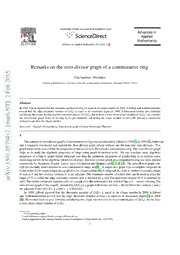Table Of ContentAdvances in
1
Applied
Mathematics
AdvancesinAppliedMathematics00(2015)1–3
Remarks on the zero-divisor graph of a commutative ring
5
1
0 TianYanzhao*,WeiQijiao
2
(SchoolofMathematics,ChengduUniversityofInformationTechnology,Chengdu610225,China)
b
e
F
2
] Abstract
T
N In1988,I.BeckshowedthatthechromaticnumberofG(Z )isequaltoitscliquenumber.In2004,S.AkbariandA.Mohammadian
n
proved that the edge chromatic number of G(Z ) is equal to its maximum degree,in 2008, J.Skowronek-kaziow give formulas
. n
h calculatingthecliquenumberandthemaximumdegreeofG(Z ),buthehaveaerroraboutcliquenumberofG(Z ),weconsider
n n
at the zero-divisor graphG(Zn) of the ring Zn.we give formulas calculating the clique number ofG(Zn).Wepresent a constructed
m methodtocalculatethecliquenumber.
[ Keywords: Digraph,Grouptheory,Zero-divisorgraph,ChineseRemainderTheorem
2
v
1.
4
0
Theconceptofzero-divisorgraphsofacommutativeringswasintroducedbyI.Beckin1988[1],In1999[2],Anderson
7
and Livingston introduced and studied the Zero-divisor graph whose vertices are the non-zero zero-divisors. This
5
0 graphturnsouttobestexhibitthepropertiesofthesetofzero-divisorsofacommutativering.Thezero-divisorgraph
. helps us to study the algebraic properties of rings using graph theoretical tools. We can translate some algebraic
1
0 propertiesof a ring to graph theory language and then the geometric propertiesof graphs help us to explore some
5 interestingresultsinthealgebraicstructuresofrings. Thezero-divisorgraphofacommutativeringhasbeenstudied
1 extensivelybyAnderson,Frazier,Lauve,Levy,LivingstonandShapiro,see[2,3,4,10]. Thezero-divisorgraphcon-
:
v cepthasrecentlybeenextendedtonon-commutativerings,see[5]. AcliqueinagraphG,isacompletesubgraphof
i G,theorderofthelargestcliqueinagraphGisitscliquenumber[6],AsubgraphK withmverticesiscalledaclique
X m
ofsizemifanytwodistinctverticesinitareadjacent.Theminimumnumberofcolorsthatcanbeusedtocolorthe
r
edgesofG is called the edge chromaticnumberand is denotedby χ (G).ThemaximumdegreeofG is denotedby
a 1
∆(G).Thevertexchromaticnumberχ(G)ofagraphG,istheminimumk forwhichG hasa k−vertex coloring.The
zero-divisorgraphoftheringsZ ,denotedbyG(Z ),isagraphwithvertexsetinZ −{0},inwhichtwoverticesxandy
n n n
areadjacentifandonlyifx,yandx·y≡0(modn).
In 1988 ,I.Beck showed that the chromatic number of G(Z ) is equal to its clique number.In 2004 S.Akbari
n
and A.Mohammadianprovedthat the edge chromatic number ofG(Z ) is equal to its maximum degree[7],in 2008
n
[8]J.Skowronek-kaziowgiveformulascalculatingthecliquenumberandthemaximumdegreeofG(Z ),buthehave
n
aerroraboutcliquenumberofG(Z ).
n
1*Correspondingauthor.
E-mailaddresses:wyjdeyx@sohu.com,qjwei@cuit.edu.cn,
ProjectsupportedbytheNationalNaturalScienceFoundationofChina(GrantNo.11471055)
1
TianYanzhao/AdvancesinAppliedMathematics00(2015)1–3 2
Forexample,n=420=22·3·5·7,G(Z )={30,42,70,210},thecliquenumberis4.n=108=22·33,G(Z )=
420 108
{6,18,36,54,72,90}.thecliquenumberis6.InthispaperwegiveformulascalculatingthecliquenumberofG(Z ).
n
let n = pα1pα2···pαs be the prime power factorization of n,where p < p ··· < p are distinct primes and
1 2 s 1 2 s
α ≥1,s≥1.
i
2. Results
Inthissection,weshowformulascalculatingthecliquenumberofG(Z ).atthesametime,wegivesomeexamples.
n
1. Vizing’sTheorem[6,p281]ForeverynonemptygraphG,theneitherχ (G)=∆(G)orχ (G)=∆(G)+1.
1 1
2. Theorem1.ThemaximaldegreeinG(Z )hasthevertexn/p andthemaximumdegreeisequalton/p −1.
n 1 1
Proof:Thisisprovedin[8]. (cid:3)
3. Theorem 2. If n is square-free,then the clique number of the graph G(Z ) is s.if αare even numbers,for all
n i
1≤i≤ s,thenthecliquenumberis pα1/2pα2/2···pαs/2−1,otherwise,thecliquenumberis
1 2 s
pδ1/2···pδr/2qβ1−1/2···qβt−1/2+t−1,
1 r 1 t
whereδ iseven,i=1,...,r,β isodd,i=1,...,t.
i i
Proof:Weconsiderthethreecase.
1.Ifnissquare-free,letn= p p ···p ,wherep aredistinctprimes,1≤i≤ s.weconsiderthesetS ={n, n ,..., n},
1 2 s i ps ps−1 p1
theproductofeverypairelementsofthesetisamultipleofn.i.e.theelementsofSisintheverticessetofG(Z ),there
n
arenomoreelementsinG(Z ),thereforethecliquenumberinthiscaseisequaltos.
n
2.Ifallα areeven,1≤i≤ s,thentheelementm= pα1/2pα2/2···pαs/2andelement2m,3m,4m,...,(m−1)mform
i 1 2 s
acliquenumberofG(Z ).theelementtisthesmallestnumbersuchthatthemultiple(m−1)mispossiblythegreatest
n
numberbelongingtoZ andthecliquenumberinthiscaseisequaltom−1.
n
3.Ifα areevenandoddnumbers,letn= pδ1/2···pδr/2qβ1−1/2···qβj−1/2·q ···q ,δ iseven(i=1,...,r),β isodd(
i 1 r 1 j 1 j i i
i= 1,..., j),p < p < ... < p ,q < q < ... < q ,Pr δ +Pj β = Ps α. Wepresentaconstructedmethodto
1 2 r 1 2 j i=1 i i=1 i i=1 i
calculatethecliquenumber.
If j=1,n= pδ1/2···pδr/2qβ1−1·q ,letk = pδ1/2···pδr/2q(β1−1)/2,weconsiderthesetA={k2,q k,2q k,3q k,...,q (k−
1 r 1 1 1 r 1 1 1 1 1
1)k},theproductofeverypairelementsoftheset Aisamultipleofn.i.e. theelementsof Aareintheverticessetof
G(Z ),theelementkisthesmallestnumbersuchthatthemultiple(k−1)kispossiblythegreatestnumberbelonging
n
toZ andthecliquenumberinthiscaseisequaltok+1−1=k.
n
If j=2,n= pδ1/2···pδr/2qβ1−1qβ2−1q q .
1 r 1 2 1 2
letk= pδ1/2···pδr/2q(β1−1)/2q(β2−1)/2.weconsiderthesetB
1 r 1 2
B={q k,q k,q q k,2q q k,3q q k,...,q q (k−1)k},theproductofeverypairelementsofthesetBisamultiple
1 2 1 2 1 2 1 2 1 2
ofn.i.e. theelementsof BisintheverticessetofG(Z ),theelementk isthesmallestnumbersuchthatthemultiple
n
q q (k−1)kispossiblythegreatestnumberbelongingtoZ andthecliquenumberinthiscaseisequaltok+2−1=k+1.
1 2 n
...........................
.
If j=t,letc=q q ···q,n= pδ1/2···pδr/2qβ1−1···qβt−1c.
1 2 t 1 r 1 t
letk= pδ1/2···pδr/2q(β1−1)/2···q(βt−1)/2.weconsiderthesetC
1 r 1 t
C = {ck/q ,ck/q ,...,ck/q,ck,2ck,3ck,...,c(k − 1)k}, the product of every pair elements of the set C is a
1 2 t
multipleofn.i.e. theelementsofC isintheverticessetofG(Z ),theelementk isthesmallestnumbersuchthatthe
n
multiplec(k−1)kispossiblythegreatestnumberbelongingtoZ andthecliquenumberinthiscaseisk+t−1. of
n
course,thenumber j∈ N.
weconcludethatthecliquenumberisequalto
pδ1/2···pδr/2q(β1−1)/2···q(βt−1)/2+t−1
1 r 1 t
theproofiscomplete. (cid:3)
2
TianYanzhao/AdvancesinAppliedMathematics00(2015)1–3 3
3. Example
(1)Ifn = 60 = 22 ·3·5,bythe theorem, the cliquenumberofG(Z ) is equalto 3. the verticesset ofG(Z )is
60 60
G(Z )={12,20,30}.
60
(2)Ifn=25·53·72,then,bythetheorem,thecliquenumberofG(Z )isequalto141.
196000
(3)Ifn=33·52·73,then,bythetheorem,thecliquenumberofG(Z )isequalto106.
231525
4. Acknowledgments
TheauthorsareindebtedtotheNationalNaturalScienceFoundationofChinaforsupport.Alsotheauthorsthank
therefereeforher/hisvaluablecomments.
References
[1] I.Beck,Coloringofcommutativerings,J,Algebra116(1988)208-226.
[2] D.F.Anderson,P.S.Livingston,TheZero-divisorgraphofacommutativering.J.Algebra217(1999)434-447.
[3] D.F.Anderson,A.Frazier,A.Lauve,P.S.Livingston,Thezero-divisorgraphofacommutativering,II,in:LectureNotesinPureandAppl.
Math.,vol.220,MarcelDekker,NewYork,2001,pp.61-72.
[4] D.F.Anderson,R.Levy,J.Shapiro,Zero-divisorgraphs,vonNeumannregularrings,andBooleanalgebras,J.PureAppl.Algebra,submitted
forpublication.
[5] S.P.Redmond,Thezero-divisorgraphofanon-commutativering,Internat.J.CommutativeRings1(4)(2002)203-211.
[6] GaryChartrand,PingZhang,IntroductiontoGraphTheory,PostsandTelecomPress,BeiJing,2006.
[7] S.Akbari,A.Mohammadian,Onthezero-divisorgraphofacommutativering,J.Algebra274(2004)847-855
[8] JoannaSkowronek-Kaziow,somedigraphsarisingfromnumbertheoryandremarksonthezero-divisorgraphofringZn,InformationProcess-
ingLetters108(2008)165-169.
[9] H.P.Yap,someTopicsinGraphTheory,in:LondonMath.Soc.LectureNoteSer.,vol.108,1986.
[10] P.S.Livingston,StructureinZero-divisorGraphsofCommutativeRing,MastersThesis,TheUniversityofTennessee,Knoxville,TN,December
1997.
3

